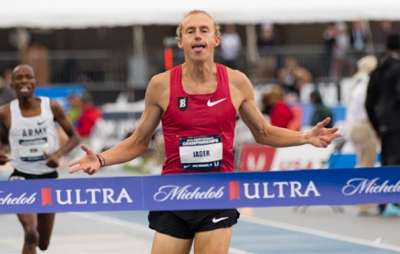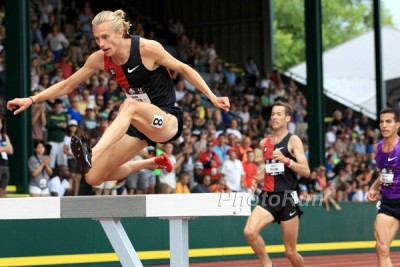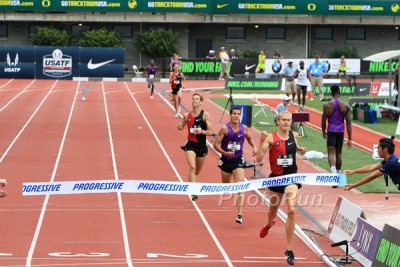Despite Injury-Plagued Winter & Spring, Evan Jager Is Planning on Defending His US Steeple Title in Des Moines
By Jonathan Gault
July 9, 2019
Note: There is a podcast out from our talk with Evan Jager that is the basis of this story. The Jager podcast is here. Subscribe today on itunes
It’s 4:10 p.m. on Saturday in Portland, and Evan Jager finally has some free time. Already today, he’s spent 50 minutes running on an AlterG anti-gravity treadmill, another 50 minutes cross-training on the elliptical, and three hours doing rehabilitation work with physiotherapist Marilou Lamy, which includes deep-tissue massage, dry needling, and strengthening exercises.
“I’ve been so much more busy being injured than I ever was healthy,” says Jager, 30, the 2016 Olympic silver and 2017 World Championship bronze medalist in the steeplechase.
Yes, injured. That’s the reason why Jager has been conspicuously absent from the elite track & field circuit in 2019, why he hasn’t raced at all since August 30, 2018.
During their session, Lamy spent time releasing the muscles in Jager’s calf and in his foot, the site of the stress fracture that has sidelined him for months. But most of the session was dedicated toward working on Jager’s upper body: his shoulders, ribs, pecs, back, triceps…the list goes on. None of those areas were strictly injured, but they’ve been tight, which Jager says is a byproduct of the mental and emotional stress generated when a professional runner cannot race for almost 11 months.
“The physio says I was carrying my stress up top,” Jager says.
Jager is back running now — finally — and he’s ready to talk. About the adductor problem that started this whole cycle last summer, about the misdiagnosed stress fracture, about the chance that his perfect seven-year win streak in the steeplechase at USAs could finally come to an end.
“It’s been a very up-and-down year since the track season,” Jager says over the phone. “I guess I’ll just start…”
***
June 15, 2019, was the day that Evan Jager finally felt like himself again.
Usually, Jager is easy to pick out in a race. At 6-2, he towers over most of his competitors in the steeplechase. Add in his golden locks — once free-flowing, now more often than not pulled back into man bun — and his airy, bouncy stride and he is immediately recognizable.
But for the previous nine months, Jager could barely recognize himself, the result of a mysterious left foot injury that just would not go away. He’d take time off, and when his doctors assured him that the injury should have healed, he’d start training again, and the pain would return. This cycle repeated three times until the middle of April, when Jager finally received the correct diagnosis: a stress fracture in the talus, the bone that sits between the heel and lower leg and helps transfer the body’s weight to the foot while walking.
Once again, Jager took a break from running, his longest yet in this injury cycle: six weeks, split between crutches and one of those silly-looking scooters you prop your knee up on. On June 15, he was in Victoria, B.C., finishing up a trip north of the border with Bowerman Track Club teammate Moh Ahmed which had also included a visit to Lamy, who is based in Vancouver.
After half a dozen runs on the AlterG, Jager finally felt ready to return to solid ground, so he set out for an easy run with Ahmed on a crushed limestone path by the Canadian Sport Institute Pacific. It wasn’t fast, and it wasn’t far, but for the first time in months, he felt like he was Evan Jager running around, not an impostor forced to make do with a compromised body. He felt…
“Awesome, obviously,” Jager says, recalling the run three weeks later. “This whole year had just felt like I had been compensating for the foot. It felt like I was just limping around running all year and I was just kind of fighting against my own body every time I was running. It just was a super frustrating, exhausting place to be in.”
Were this a normal world championship year with Worlds in August, 2019 may have gone down as a lost season for Jager. But because of the heat in Doha, the 2019 World Championships have their latest starting date ever, September 27, and as a result, the USATF Outdoor Championships were pushed back a month. The first round of the men’s steeplechase at USAs will be held on July 25 in Des Moines, 16 days from now, and Jager fully intends to be on the start line — even if he’ll only have been running on solid ground for 40 days.
***
The problems began in May 2018. Whenever Jager would start a run, or a stride, or a workout, he’d feel a tearing sensation creeping up from his adductor into his lower abs. He’d feel it outside of running too, whenever he sat up or sneezed. But he was in the middle of the track season, and it wasn’t stopping him from running, so he did what anyone does when they can’t fix an injury: he adjusted.
“To protect myself, I stopped using my abs and started using my upper body as a way to brace myself,” Jager says. “So anytime I would stand up, I would use my arms to push myself up and then stand up.”
Jager could still train, and his racing didn’t suffer — he won USAs in June and ran 8:01.02 in Monaco on July 20, the second-fastest time of his career. But his core strength was wasting away, and his form changed subtly to compensate. Jager believes that change contributed to the foot injury that ruined his winter and spring.
It happened at the Diamond League final in Zurich. The day before the race, Jager underwent an MRI which revealed a tear in his iliacus muscle in his pelvis — the result of that ab pain Jager had been experiencing. Jager decided he could handle the pain and race through it.
Midway through the race in Zurich, Jager landed hard on his left foot coming off a water jump. He could tell immediately that it was not a normal impact.
That definitely hurt, Jager thought.
Riding high on adrenaline, the pain subsided within 200 meters and Jager stayed in the race. After all, this was the same race in which Conseslus Kipruto kicked to the win with one shoe. Jager wound up third in 8:13.22, behind Kipruto and Morocco’s Soufiane El Bakkali.
After the race, Jager’s foot was still sore, and he believed his earlier injuries were the root cause.
“I think it must have just thrown things off just enough to where I wasn’t running and jumping like my normal self,” Jager says. “On the landing, I didn’t have the strength to absorb the impact as I normally would because of the iliacus tear.”
He wound up scratching from the Continental Cup at the last minute and returned to the States for an MRI, which he was told revealed a bone bruise. Jager was instructed to take three weeks off from running to allow the bruise to heal.
When Jager returned after three weeks, so did the pain. He took four more weeks off. When he returned from that, he still felt pain, but kept training through it.
“People that I talked to were assuring me that after seven weeks of no running, the bone should definitely be healed,” Jager says. “I must just be dealing with residual pain.”
Jager hobbled through the winter season, during which he didn’t race, as a shadow of himself. He gutted through workouts, but was in constant discomfort. And rather than controlling the pain, as he had tried to do during the 2018 track season, the pain was now controlling him.
“My body was just not letting me run in its normal pattern because that would have been painful,” Jager says. “And so it was just automatically shutting some muscles off from running normally.”
As the weeks wore on, Jager’s frustration continued to mount. He had been assured repeatedly that his foot had healed, but his foot was telling him differently. He stopped logging many of his runs. That was Evan Jager’s log, and he wasn’t feeling much like Evan Jager.
Things came to a head one day in late March. Jager was at the Michael Johnson Track on Nike’s campus in Beaverton, running a session of repeat 200s around 30-second pace, a workout he’d usually complete with ease.
But he felt tight, rigid, and Jerry Schumacher, his coach of over a decade, could tell. The trademark loose, bouncy Jager stride was nowhere to be seen.
“Jerry kept telling me to relax,” Jager says. “He’s like, ‘You’re not running, just relax. Run loose.’ I was like, ‘I can’t do that.’ He’s like, ‘Yes, you can, you just need to forget about having good form and let your body flow.’
“And literally, I could not do it. It was a very helpless feeling.”
A few weeks later, Jager went for another MRI. The result wasn’t good, but it confirmed that Jager wasn’t crazy. He had been misdiagnosed in the fall.
“We took the results to another radiologist different from the one this fall,” Jager says. “And he read this report and I gave him the images from the MRI done in September, and he read that and he’s like, ‘Oh yeah, looking at this, I would have classified this as an impact fracture instead of a bone bruise.'”
Jager’s actual injury, an impact fracture of the talus bone, is more common among snowboarders — it requires one to land hard on one’s heel, with the force of impact driving up through the calcaneus (heel) bone and into the talus. It’s rare among runners, but not unprecedented. Conseslus Kipruto, the reigning Olympic and world champion in the steeplechase and one of Jager’s chief rivals, has also missed all of the 2019 track season to date with a talus injury.
Jager was forced onto crutches for six weeks — he tried a walking boot at first, but even then he still felt pain — during which time he spent two to three hours a day cross training, either on the exercise bike or in the pool, aqua jogging or swimming. As any injured runner knows, cross-training can become mind-numbingly boring. But more than that, it’s just plain lonely.
Occasionally, Bowerman teammates Colleen Quigley or Marc Scott might stop by for some pool work — Quigley is a strong swimmer, so Jager would get competitive and try to keep up with her. Jager would still get together with the BTC guys from time to time, still send messages in their text thread. But he wasn’t out there sweating with them in workouts or long runs. He didn’t go to altitude with them like usual. He felt incomplete.
“There is a part of you that feels like you’re not really on the team because you’re not running every day,” Jager says. “…It’s just awkward. It’s just not fun.”
***
Jager has never lost a steeplechase final at USAs, winning seven straight titles since debuting in the event in 2012, and it’s a streak he’s fiercely protective of. Last year in Des Moines, a year in which there was no World or Olympic team to make, Jager sat through a two-hour, 54-minute lightning delay before prevailing, and said he would have stayed longer if he had to.
“I was ready to go at 1 [a.m.], 2 [a.m.], whenever, it didn’t matter. If they wanted to bring us back tomorrow that was fine with me,” Jager said.
That win gave Jager seven straight titles, replicating the feat of Henry Marsh (1981-87); no man has ever won eight in a row in the steeple. Jager knows that this year will be his toughest test yet, especially after Hillary Bor ran 8:08.40 (#3 in US history) earlier this season in Doha. But if Jager can just finish in the top three, he could buy himself another two months to get fit for Worlds.
Right now, Jager describes his training as a “get fit quick” program: rather than running two longer workouts per week, he is doing shorter sessions but more of them. He has run roughly 50-55 miles a week for the last two weeks, which he’s continued to supplement with cross training.
“I think I have the opportunity to gain a ton of fitness in the next three weeks just based off the fact that I’m three weeks into running,” Jager says.
Jager hasn’t been over a barrier since Zurich, and though he’ll have to clear a total of 70 of them between the semis and final in Des Moines in order to make the team, he’s in no rush on that front. Jager has always been an ambidextrous hurdler, but says that if he gets to race day and still doesn’t trust his foot, he’ll hurdle one-legged (Jager would plan to jump off on his right foot for every jump, which would also allow him to land on his right foot in the water jump).
“I’m going to take things as they come,” says Jager, who hasn’t ruled out racing before USAs. “I’m not gonna try to do water jumps a lot just to do them, just to get ready for the race. I’ll squeeze in hurdling and water jumps when I feel like my body is ready to do those things.”
Jager has never been an underdog in the steeplechase at USAs. Even in his first appearance, in 2012, with a grand total of two lifetime steeples in his legs, he was the favorite to win and did just that. This time around, Jager knows he’s vulnerable. But the man who owns the nine fastest times ever in the steeple by an American is not counting himself out, either.
“I would definitely be a little bummed to go to USAs and not win,” Jager says. “But at the same time, I feel like if I can make this team with everything I’ve dealt with the last year, I would still be super proud of myself.”
Talk about this article on our world famous fan forum / messageboard. MB: Evan Jager Will Attempt To Win His 8th Straight US Title After Just 40 Days of Running – Is It Enough?
Note: There is a podcast out from our talk with Evan Jager that is the basis of this story. The Jager podcast is here. Subscribe today on itunes





